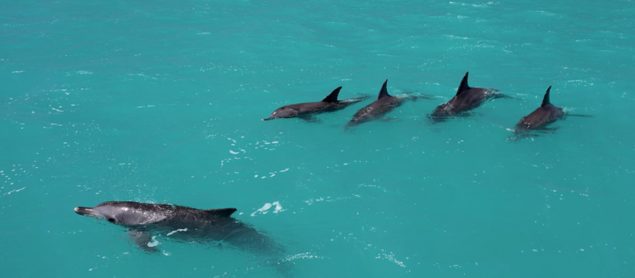|
Getting your Trinity Audio player ready...
|
Researchers now say some dolphins can actually form multiple levels of alliances among their societies — long-thought to be a unique characteristic of human societies.
People establish strategic, cooperative relationships at different social levels for a variety of reasons including economic advantage, international trade and military operations. For male bottlenose dolphins living in Shark Bay, Australia, the motivation is a little less complex — the ladies. These dolphins actually form at least three different levels of cooperative relationships between groups to increase male access to females, according to the new study led by Richard Connor, a Florida International University biologist and professor emeritus at the University of Massachusetts at Dartmouth, and Stephanie King, an associate professor from the University of Bristol.
The male dolphins in Shark Bay form first-order alliances of two or three males to cooperatively pursue consortships with individual females. Their second-order alliances can include as few as four and as many as 14 unrelated males to compete with other alliances over access to females. Their third-order alliances occur between cooperating second-order alliances. The research team analyzed association and consortship data to model the structure of alliances among 121 adult male Indo-Pacific bottlenose dolphins, demonstrating the dolphins have the largest known alliance network outside of humans.
A key finding of the study is the importance of intergroup cooperation for male success. Intergroup cooperation in humans was thought to be unique and dependent upon two other features that distinguish humans from chimpanzees — the evolution of pair bonds and parental care by males. However, Connor said the research shows intergroup alliances can actually emerge without these features and from a social and mating system that is more like chimpanzees. According to King, this means cooperation among groups is more important than overall alliance size to increase access to females. Long story short, collaborative dolphins have greater reproductive success.
The research was published in The Proceedings of the National Academy of Sciences on the heels of the 40thanniversary of when Connor first began dolphin research in Shark Bay and the 30th anniversary of a major research study that announced the discovery of the dolphins forming two levels of alliances there. That research was also published in The Proceedings of the National Academy of Sciences.
Simon Allen, a senior lecturer at the University of Bristol, Michael Krützen, head of the Anthropology Institute at the University of Zurich, and William B. Sherwin, a professor at the University of New South Wales, also contributed to the study.






